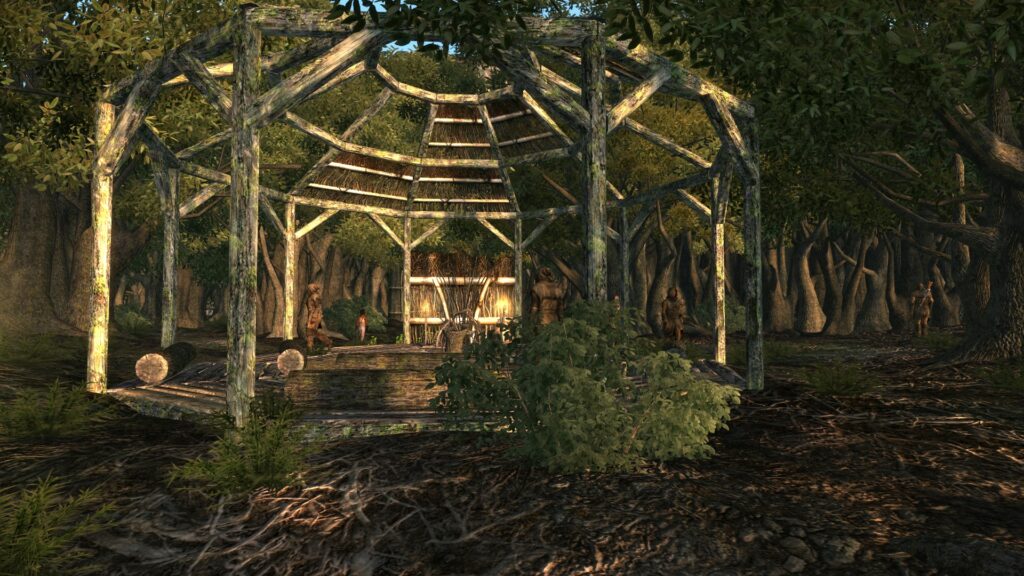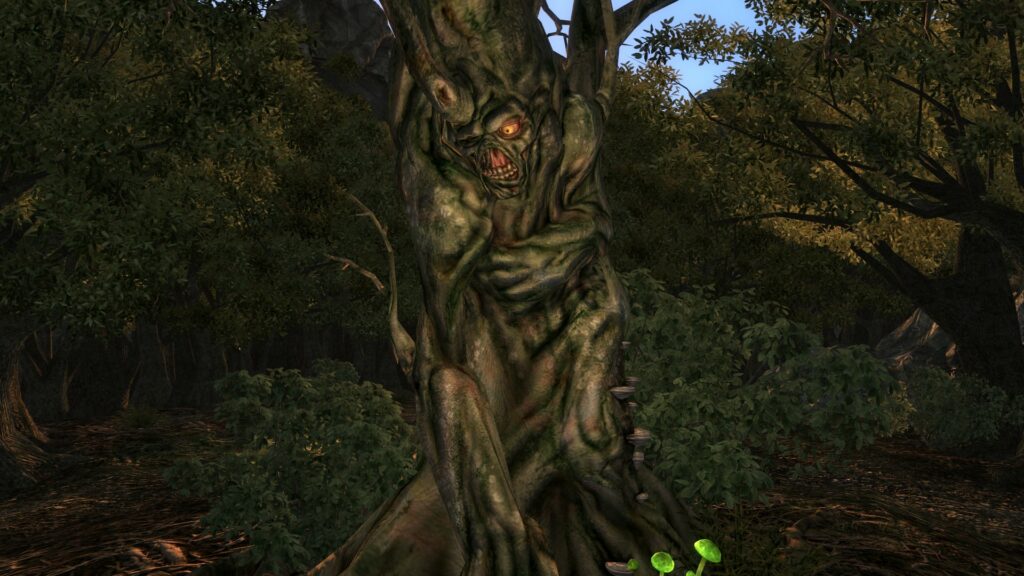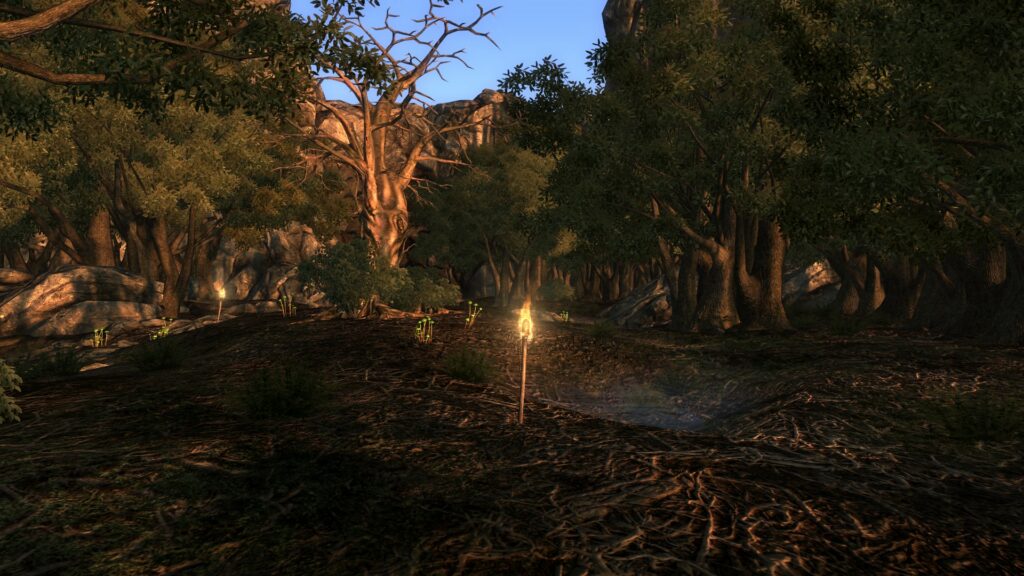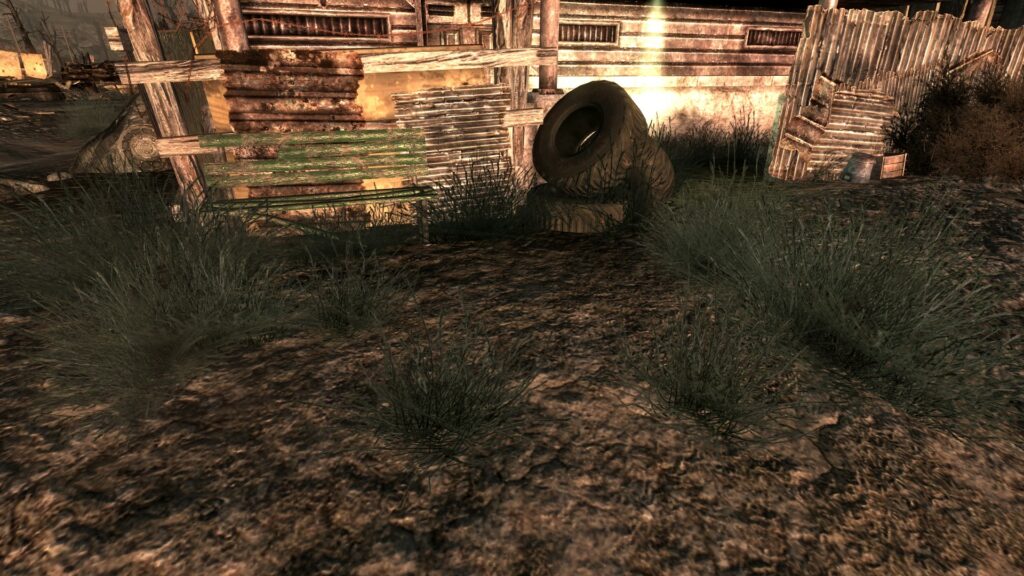
So this time I’m going to be looking at Oasis and a nearby new location I’ll be adding. First of all, let me say this: I hate Bethesda for what they did to Harold. He’s a fun and interesting character, and having him shoehorned in as a living god-tree is just… *sigh*
That being the case, I’ll be changing it entirely. No more silly god-tree, no more dumbass tree minders, no more Oasis. The location itself will exist, but it won’t be filled with tree-hugging hippies and will instead be something rather more morally grey, with an unpleasant history leading the player to actually have to make a difficult decision on how to deal with the uh… inhabitants.
But first, Harold. He’ll still be around the world. We can say that he headed out east and just continued walking (well… probably the post-apoc equivalent of hitchhiking, really, considering the trouble he’d have walking that distance), or alternatively we can say he’s here in DC for a specific reason. I’ll be going with a specific reason I’ll get to later, but either way, his presence isn’t offensive in and of itself. It’s how he’s presented that’s the problem.
It feels like someone sat down with the Fallout Wikia and hit the random page button, got Harold as a result, and thought, ‘Hmm… interesting, he has a tree growing out of his head, I wonder if we could use that… wait, wait… WAIT… I’ve got it! We can turn him into a tree! Fucking genius, gaming is saved, guys.’
Anyway, I don’t want to spend ages ranting on Harold, I’ll cover him later, but for now you just need to know that he ain’t a tree-god in Oasis any more. Moving on!

So if Harold isn’t around, what is Oasis going to be? Well, for starters it’s going to be roughly similar in concept; a particularly lush area being sustained by an entity you’ll meet upon entering the general location. But since my entire wasteland is pretty lush, it’ll be less of a major focus compared to Oasis itself. However, it will also be home to certain other things not found elsewhere in the world.
Upon entering you’ll be confronted with an odd sight; people with an unusual green tint to their skin shuffling around the general area, almost zombie-like. Immediately it will be clear something is off here, and the player might well suspect these people are cultists, or off their faces on chems, or all manner of other possible weirdness.
They will talk to you, but have trouble stringing together coherent sentences, reinforcing the idea that they’re stoned or half-dead or something. Moving further in with some minor nudging from the residents, the player will start to notice highly unusual flora; tendrils and creepers dripping with a sticky liquid, all exuding an unpleasant yellow-green vapour. You’ll eventually come to the area where Harold stands in the original game, but it won’t be Harold. In his place is a monstrosity, something like a cross between a Venus fly trap and the Sarlacc. (Without the silly beak, though.)

A gaping maw in the centre is surrounded by tentacles and various greenery plus half a dozen Venus fly trap-like mouths on flexible tentacles, the whole thing settled into a large sink hole with its main body in the caverns below ground.
The player’s first urge might well be to flamethrower it, but we can potentially put a pacification field in place (similar to Big MT’s Think Tank) to prevent that before the plant-creature can speak. Maybe they’re overcome by the spores in the atmosphere, allowing the creature the time it needs to initiate dialogue (with a potential quest to purify yourself if you don’t want to do the main quest associated with the location). I dislike taking control away from the player, but sometimes it does make some amount of sense.
At this point it’ll talk to the player, probably via some form of telepathy. Except it’s not really telepathy, it’s the creature’s spores in the atmosphere; contact with your skin or even being ingested basically allow the creature to communicate via images and patterns shown directly in the player character’s mind. For this we’d probably have to do something similar to Christine’s sections in Dead Money, allowing for various speech / perception type checks.
(Note: while I like this general idea, it might also cause some problems with power armour-clad players, since the spores naturally wouldn’t be able to penetrate such a self-contained system. But hey, maybe that just means you don’t get to speak to it unless you expose yourself by removing the armour first.)
Introducing itself simply as the ‘Gestalt’, any player with a reasonable grasp of the English language should immediately have suspicions about the plant-creature’s origins, which will be revealed through dialogue and—either before or after this point, depending on when you find it—terminal entries, diaries, and audio logs at a nearby facility.
Basically, a nearby civilian Pre-War facility was running a variety of government-sanctioned experiments on plants, toying with accelerated plant growth for purposes of creating bio-ethanol in quantities sufficient to fuel the American war machine (Bethesda routinely forgets that the oil ran out in this universe, of course). Similar to Vault 22, but with different purpose and without being co-opted by Big MT.
Additional experiments using the vast quantities of plant and animal matter they had access to also took place, attempting to bio-engineer new hybrids and all manner of other crazy things. Effectively they took their government-sanctioned status and ran with it, experimenting with anything they possibly could… regardless of how messed up or unethical (not so different to the Big MT scientists actually…).

In any case, with a facility messing around with all kinds of crazy crap, the general idea is that they began experimenting with plants and the idea of new forms of data storage, hoping they could make some breakthroughs by storing data in living organisms, basically like that idea in our world of using DNA for storing insane quantities of data. Eventually this led them down the path of attempting to store actual human memories in genetically bred plant material.
And then the Great War happened. At this point the scientists and staff considered they were dead regardless, so they hastily attempted to transfer all their combined memories and knowledge into the test subjects—figuring that plant matter is actually very resilient to radiation—resulting in the gestalt entity you’re currently speaking to. It became self-aware, used the lab to tinker with its own form and function, and eventually gained the ability to move about, albeit in a slow and lumbering fashion.
Over time it grew more and more aware of its own capabilities, using spores sent out from the facility’s vent system to explore the surface world, and seeing what it was capable of. Infecting animals with its spores, it attempted to control them, knowing instinctively that it would need sustenance if it was to survive, and having enough of its human progenitors’ memories, it knew targeting humans would be risky.
As it turns out, it’s actually quite difficult overriding an animal’s instincts to the point of being able to take full control over long distances, so the Gestalt instead had to look elsewhere. Something interesting came of this; despite the potential danger, humans were pretty easy to manipulate because they’re sapient and can therefore be nudged in a particular direction without necessarily needing to take full control.
As a result, the Gestalt hooked any lone wanderers it could find, tugging them into its radius of direct control so it could take over fully and turn them into thralls to tend to its needs, giving rise to the people you first meet upon entry. Then it simply needed to keep its eyes open—in a manner of speaking—for potential prey to pull into its traps for sustenance.
Raiders and other thugs turned out to be good candidates because while sapient (for a given value of sapient…), they also act based heavily on impulse and are easily swayed by shiny loot or the potential for violence / sex / action / excitement. By simply tapping into these baser urges, the Gestalt could lure individual raiders away and consume them at its leisure.
This had an additional benefit in that raiders are rarely missed. They mostly only care about their loot and where the next target to rape, kill, and pillage is coming from. It’s not rare for raiders to simply drop dead from drug overdose or disappear without trace, making a useful source of food for the Gestalt while remaining hidden itself.
Eventually the Gestalt outgrew its facility and decided to attempt a trek out into the wastes with the hopes of finding a new place to call home, before growing to a size at which it could no longer easily move. Having learned all it felt it needed to from the facility’s terminals, and of course exploring its own memories, it didn’t need the lab itself any more, instead wanting an open area in which to grow.
Clumsily and slowly dragging itself via its many tentacles and tendrils, the Gestalt gradually moved out of the facility (we could say this replaces Vault 92, or maybe make a new one just south of Oasis) and lumbered as speedily as it could manage to a grove it had discovered by sending some of its thralls out to explore; the location had been shielded from much damage or radiation thanks to high rock walls all around, making it a perfect place to put down roots.
The Gestalt arrived at what we know as Oasis, discovered the spacious caverns below ground, and plonked itself down, putting out feelers and roots in all directions, hooking up its pods and traps (think along the lines of Venus Fly Traps and Pitcher Plants and you’d be pretty close), and settling down comfortably in its new home. New thralls were acquired as necessary, both for food and to tend to its needs, and the years began passing by…

So we have a location with a creature with which to have conversations in a highly unusual fashion using images and memories rather than direct speech, potential for a number of new quests, and even some beneficial items the player will get some use out of.
Let’s say the Gestalt exudes a sap of some sort that’s highly beneficial to humans. Maybe it’s a good healing item, or it gives buffs, or it can be combined with various other things to make extremely potent healing items, buffs, or poisons (similar to Honest Hearts’ new recipes). This gives the player a tangible benefit for helping the Gestalt, but also gives the creature itself a tradable commodity.
You know what’s coming next if you’ve been reading this series since the start. Let’s tie the Gestalt into the wider world! First up, it needs a steady source of food. Exploring the caverns beneath the creature, the player will discover dozens, potentially hundreds of skeletal remains of all the people the Gestalt has consumed over the last hundred or more years (given the elderly Gamebryo engine, we might have to settle for a dozen *sigh*). But since this should generally happen after speaking to it, the player probably has a more informed view of things and can come to a decision without relying entirely on visceral emotion.
The Gestalt needs the player in order to improve its lot in life, and therefore the creature has decided it’s best to simply be honest and hope the player will understand its situation. Sure, it’s eaten a crapload of people, but it’s done so simply out of necessity since animals rarely wander in here and can’t be controlled in the same way a person can; it was never out of malice.
In the last part I spoke about the Dish Runners. Let’s use them here. First, we can go the simple route and agree to lure the Raiders across piecemeal for the Gestalt to munch on. Like Old Olney, we could again make use of the Mesmetron to make things easier, but this also opens up an evil route for players who want to be maximum awful to the people of the Wasteland.
Beyond the simple option of luring people over to feed the Gestalt, the rather more morally good option would be to head across to Big Town. Remember I mentioned they could be a thriving hunter / animal husbandry community? Yup, so let’s have them enter into something of a trading relationship with the Gestalt.
An agreement can be reached where the Gestalt will stop consuming people—even scum like raiders, something it only did out of necessity anyway—and instead eat animals, but it will require human help to hunt those animals. As the Gestalt can’t actively hunt by itself, it’s thralls simply aren’t capable of that sort of physical activity and its spores don’t work, it needs others to do so on its behalf, plus its traps are pretty sporadic at capturing prey since so little naturally lives in this area.
Big Town can therefore provide regular shipments of fresh meat to the Gestalt, and in return the creature provides a good quantity of its sap for medicinal and other purposes. In addition to this, remember the other thing I mentioned that Big Town were experimenting with? Biofuels!
The Gestalt is therefore in a position to help with their research, even giving them the location to the facility and letting them use the various materials there—including the incredibly fast-growing plants—to further their production of fuel, helping Big Town even more.
It might take a little while for a real trust to form between the two settlements, given the creature is keen to remain low key and Big Town is going to be wary of a carnivorous semi-sapient plant, but the ending slides would show the two got along fine (or not, depending how you play it).

Other quests can easily tie into this set up as well of course, like having the Dish Runners be suspicious that they’re losing more than the usual number of people (if we say the Gestalt has been abducting them since before making contact with the player). As an evil type, the player can agree to help the Dish Runners figure out what’s going on, potentially resulting in flame-throwering the Gestalt and expanding the Runners’ influence into another new area.
You could persuade the raiders to move to Oasis (we could say this was a touristy sort of spot, Pre-War, and Oasis was the name at the time, gives a reason for it being called that), upon which the Gestalt would take control and gain a sizeable stock of food plus new thralls. Similar to the nuke option I discussed in the last part, this would drastically reduce the raider population in the wastes in a similar fashion.
There’s also a location I’ll be discussing soon involving a faction sympathetic to the plight of cannibals, so again that’s a potential way to help the plant gain some food. I’ll chat more about specifics when I talk about that faction and their associated settlement.
Additional options can include helping some of the other settlements fix their food issues by making use of the super-grow technology from the facility. Rivet City would be especially interested in this, allowing them to be even more self-sufficient, and Canterbury Mega Commons might even want to prevent such a thing from occurring, since it would interfere with their own trade goods, and they’d rather have that tech themselves.
Couple of final things. This creature gives us a similar situation to the Master in Fallout, whereby we have an entity that absorbs others in order to improve itself, but unlike the Master, the Gestalt doesn’t gain any of the intelligence or memories or similar from those it consumes. It’s purely a biological necessity of being born from various plants—some carnivorous—having been forcibly mashed together. It would need the facility to implant memories like the original scientists did.
Survival as a skill would also be in the game, and putting points into this stat would be required to get the most from the Gestalt’s sap. Low Survival might give penalties if the sap is used, and recipes using the sap wouldn’t unlock without a reasonable amount of points invested in this skill. Likewise, you’d be able to help Big Town’s scientists unlock the full potential of the sap if you have high skill.
And finally, in the event the player has low speech or perception (and potentially other important skills / SPECIAL stats) and can’t understand the Gestalt, Harold is in the wasteland and—if found and spoken to—will unlock speech options to have him come and speak to the Gestalt on your behalf.
My thinking with this is that because Harold thinks of his tree (Bob) as sapient (sap… ohoho) he has the ability to understand the Gestalt and communicate with it, an almost empathic natural ability due to his unique situation. This gives us a secondary reason for having Harold be around, and lets even players who’ve created builds incompatible with the Gestalt complete its quests, albeit with some difficulties.
Next up will be a quick chapter talking a little about some of the smaller locations in the world including the DC ruins themselves.
If you enjoy my work, consider buying me a coffee, or jump onto my newsletter to receive updates, free chapters, stories, and other goodies.


